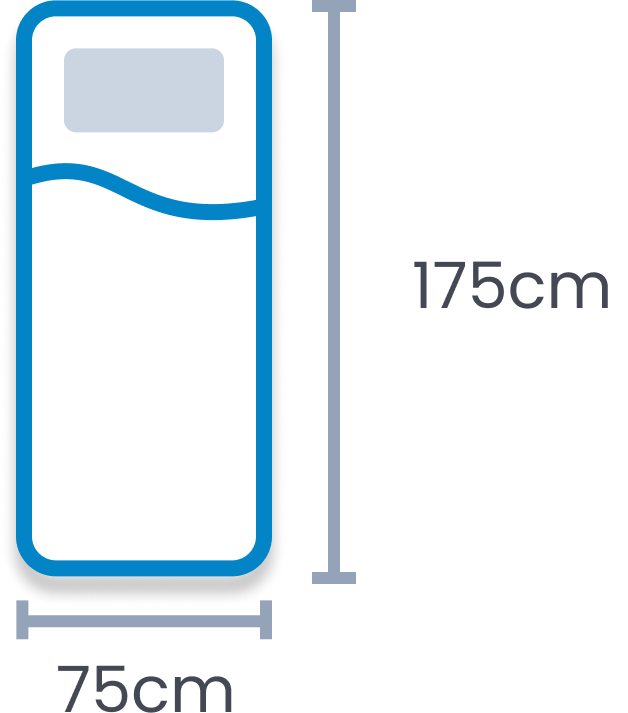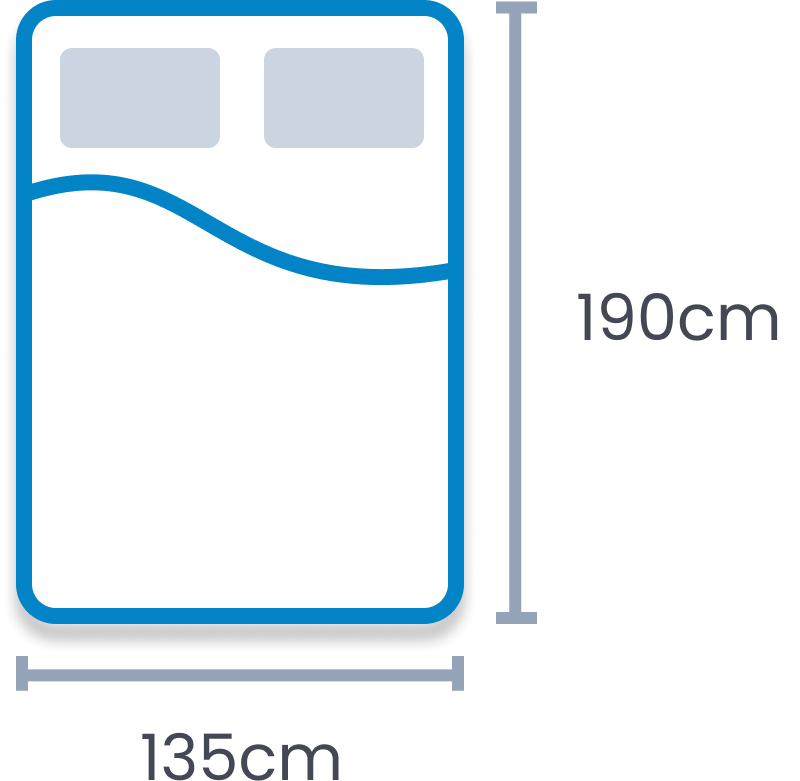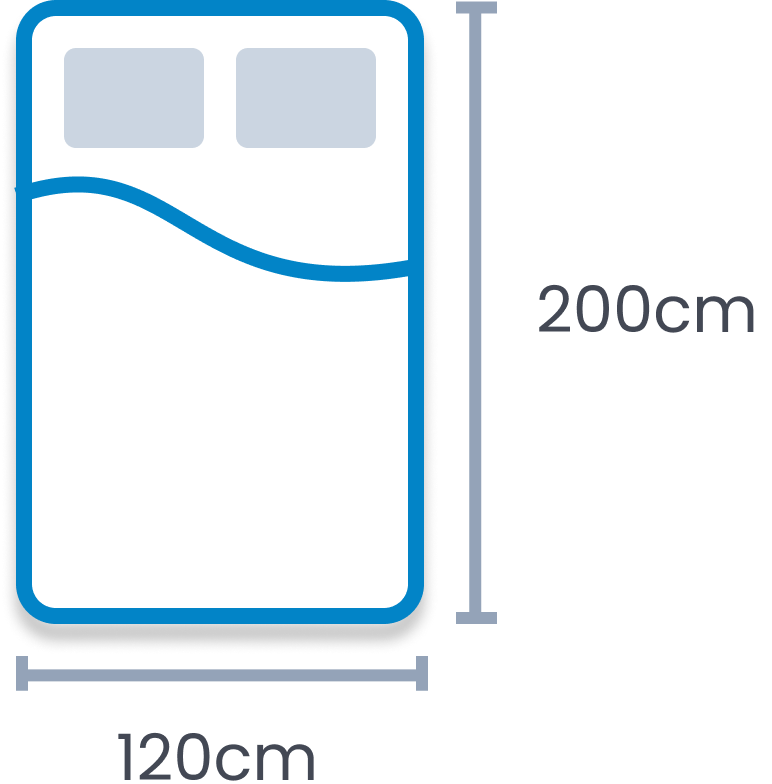Your bed is an investment that can last you for years and promote healthier sleep. And that’s why buying a new one can be a tough decision.
Pick one that’s too small, you won’t sleep a wink. Pick one that’s too big, there’s not enough space in your bedroom. But with just the right size bed and mattress, you can find the perfect balance between comfort and efficiency.
This guide has everything you need to find the right bed and mattress size for you, your sleep habits, and your space. Choose a size below to get started.

Single Bed W 90cm x L 190cm

Small Single Bed W 75cm x L 190cm

Double Bed W 135cm x L 190cm

Small Double Bed W 120cm x L 190cm

King Bed W 150cm x L 200cm

Super King Bed W 180cm x L 200cm

Cot W 60cm x L 120cm

Toddler Bed W 70cm x L 140cm

Shorty Bed W 75cm x L 175cm
UK Bed and Mattress Sizes
Not sure which bed & mattress size is best for your space? Use the guide below to find the perfect match when it comes to UK bed sizes.
| Bed Sizes | W x L (cm) | W x L (ft) |
|---|---|---|
| Cot | 60 x 120 | 2’0" x 4’0" |
| Toddler Bed | 70 x 140 | 2’3" x 4’6" |
| Shorty Bed | 75 x 175 | 2’5" x 5’8" |
| Single Bed | 90 x 190 | 3’0" x 6’3" |
| Small Single Bed | 75 x 190 | 2’5" x 6’3" |
| Double Bed | 135 x 190 | 4’5" x 6’3" |
| Small Double Bed | 120 x 190 | 4’0" x 6’3" |
| King Bed | 150 x 200 | 5’0" x 6’6" |
| Super King Bed | 180 x 200 | 6’0" x 6’6" |
Cot Bed Size

Suitable for
Cots are tiny and best for babies and children younger than two years old.
These mattresses are usually thick and firm, providing a lot of support for your growing child. If your little one is too big for a crib, but not quite ready for a toddler bed, a cot might be the solution you’ve been looking for.
Weight capacity of 250 pounds (113 kg).
Pros & Cons
- Ideal for babies and small toddlers
- Doesn't take up a lot of space
- Affordable bedding
- Easy to assemble
- Usually lightweight
- Only fits small children
- Kids outgrow cots quickly
- Cot beds are more expensive than cots
- Tough to repurpose
- Can be low-quality
Duvet & Sheet Sizes
Cot beds are very short and very narrow, measuring 60 x 120 cm in most cases.
Although we don't recommend a ton of bedding for a cot bed since they're designed for babies, Mattress Protectors' target='_self' >mattress protectors or mattress covers are ideal. These can measure 120 x 150 cm as well, or maybe a few centimetres larger.
Room Size
Cot beds are perfect for a child's nursery or next to a parent's bed. They're small, short, and narrow with a small footprint. So they can fit just about anywhere you want your child to safely sleep.
Toddler Bed Size

Suitable for
Fit for kiddos between two and four, toddler beds don’t take up a ton of space, but offer a ton of space for your little one. Even though toddlers grow up quickly, these are often affordable options to help your child transition to a starter or single bed.
Transition your little one from a little mattress to a bigger one with a starter bed. These are perfect for smaller kids, smaller spaces, and people on a budget.
Weight capacity of 250 pounds (113 kg).
Pros & Cons
- Budget-friendly
- Fit in small, narrow spaces
- Helps kids transition from cots
- Easy to move
- Easy to assemble
- Kids outgrow these fast
- Difficult to repurpose
- Not ideal for older kids
- Fewer options
- Limited sleeping space
Duvet & Sheet Sizes
Toddler beds are short and narrow. Bedding for these beds is usually on the smaller size, making it a cost-effective choice for parents on a budget.
Shop for duvets, sheets, and mattress covers that measure at least 120 x 150 cm. Anything smaller and they'll be a tight fit. If you can, opt for brands that have a few centimetres extra to account for shrinkage.
Room Size
Toddler beds can fit just about anywhere. From small bedrooms to guest rooms to next to a parent's bed.
They're short, narrow, and have a small footprint, making them easy to position in most rooms.
Shorty Bed Size

Suitable for
Too big for a cot, or a toddler bed? A shorty bed is great for older toddlers around age four.
Help your child transition to a big kid bed with these short and narrow kids' beds - perfect for small kids, and small bedrooms.
Weight capacity of 250 pounds (113 kg).
Pros & Cons
- Perfect for kids around four
- Help kids transition to a bigger bed
- Easy to assemble
- Typically lightweight
- Ideal for small bedrooms
- Not versatile
- Only fits toddlers
- Kids outgrow shorty bed fast
- Limited bedding options
- Limited sleeping area
Duvet & Sheet Sizes
Shorty beds are absolutely perfect for kids around age four. But, bedding for shorty beds can be a challenge since it's such a specific size.
We suggest investing in sheets and other bedding that's 120 x 180 cm (or maybe a few centimetres bigger in each direction).
Room Size
Shorty beds work well in small and narrow spaces, especially children's bedrooms and nurseries. They don't take up a ton of space, making them easy to position around the room if necessary.
Single Bed Size

Suitable for
Single beds are versatile. But! Typically only for one person, hence the name. They’re great for solo sleepers and small spaces. Plus, many parents find they’re the ideal choice for kids, everywhere from pre-teens to teenagers.
Weight capacity of 250 - 300 pounds (113 - 159 kg).
Pros & Cons
- Compact beds with small footprints
- Great for solo sleepers and side sleepers
- Ideal for smaller bedrooms
- Not a ton of room to stretch out
- Not great for couples
- Can make large rooms look small
Duvet & Sheet Sizes
For single beds, choose duvet and sheets that are at least 125 x 200 cm. You can go bigger by just a few centimetres, but any more than that and your bed will swim in those sheets.
Room Size
If you have a small bedroom, guest room, office, or dorm room, go with a single bed. They're compact, so they're great for compact spaces.
Got a bigger room? Splurge on a bigger bed. Otherwise, your big room will look really small with a single bed.
Small Single Bed Size

Suitable for
Guest rooms, dorms, offices, and children’s bedrooms.
You can easily create more space in even smaller spaces with a small single bed. These are about the same size as single beds, but they’re a little more narrow.
Weight capacity of 250 - 400 pounds (113 - 181 kg).
Pros & Cons
- Easy to move
- Best for children
- Space-saving
- Affordable
- Good for solo sleepers
- Limited comfort
- Limited lifespan
- Fewer options
- Too small for adults
- Too small for couples
Duvet & Sheet Sizes
The good news is, the smaller the bed, the smaller the sheets — and smaller sheets are more affordable than bigger ones.
If you've got a small single or you're ready to buy one, make sure you buy sheets or duvet covers that are at least 140 x 200 cm for a comfortable fit.
Room Size
Small single beds are even more narrow than traditional single beds — but they're the same length.
So they'll fit in (very) small bedrooms, college dorms, and even offices that double as guest rooms.
Double Bed Size

Suitable for
Couples, people with pets, and solo sleepers who want some more room.
If you need a little more space, but don’t want a ton of extra length, go for the double bed. They’re as long as single beds, but offer a wider sleeping area.
Weight capacity is 500 - 800 pounds (227 - 362 kg).
Pros & Cons
- Comfortably fit couples
- Great for people with pets that sleep in the bed
- Suitable for medium-sized rooms
- Lots of options
- Good for back- and side-sleepers
- Difficult to move
- Usually too big for small bedrooms
- Same length as single beds
- More expensive
- Limited Privacy
Duvet & Sheet Sizes
Shopping for sheets or duvets for a double bed? Good news! It's a common size that's easy to find in most stores.
Look for anything that's 241 x 249 cm or just a smidge bigger. Sometimes sheets shrink or don't fit exactly as advertised — so a few centimetres bigger is ok.
Room Size
Double beds are best for standard-sized bedrooms, or those sized about 3.65 x 3.65 m. Of course, they can fit in larger rooms, but they'll look a little cramped in anything on the smaller size.
Small Double Bed Size

Suitable for
Anyone who wants the “sweet spot” between a single and a double.
Small doubles are the same length as singles and doubles, but sit right between the two in terms of width. Double beds are perfect for solo sleepers, and couples who sleep on their sides.
Weight capacity is 500 - 800 pounds (227 - 362 kg).
Pros & Cons
- Compact size and footprint
- Great for single people
- Best for side sleepers
- Good for small or oddly-shaped rooms
- Easy to move
- Not ideal for couples
- More narrow than regular doubles
- Not as common as double beds
- Limited bedding options
- More expensive
Duvet & Sheet Sizes
Small doubles are as long as traditional double beds but they're about 15 cm more narrow. As you shop for sheets, duvets, mattress covers, and so on, make sure you buy something that's 170 cm wide, and 200 cm long.
Room Size
Standard bedrooms are just shy of 4 x 4 m — and a double bed will fit perfectly inside those dimensions.
Small doubles can also fit in bedrooms slightly smaller, but it may be a bit tight.
King Bed Size

Suitable for
Couples, solo sleepers, tall people, co-sleeping families, or people with tons of pets.
Experience true luxury with a king-size mattress. These giants take up a ton of space — so you’ll need a big bedroom. But if you’ve got the dimensions, a king is great for pretty much anyone.
Weight capacity of 800 - 1,000 pounds (362 - 453 kg).
Pros & Cons
- Big enough for families that co-sleep
- Long enough for taller people
- Wide enough for couples
- Ideal for any type of sleeper/sleeping positions
- More attractive than other kinds of beds
- Bigger bed means bigger sheets
- Not ideal for small bedrooms
- More expensive bed frames
- Difficult to assemble
- Difficult to move
Duvet & Sheet Sizes
Shopping for a king bed or already have one? Make sure you pick up some sheets that are at least 282 x 249 cm. Anything smaller, and it'll be a tough fit.
You can shop for duvets and sheets that are a little bigger. But anything outside of a couple of centimetres and you'll need sheet fasteners to keep them in place.
Room Size
Large bedrooms are 4.2 X 4.8 m — sometimes a little bigger or a little smaller. But they're large enough to comfortably fit a king-size bed, mattress, and frame. King-size furniture is large — so make sure there's enough room for it all before you buy.
Super King Bed Size

Suitable for
Couples, families that co-sleep, people who want more space, and people who want a more luxurious sleeping experience.
Super king mattresses offer even more width than a traditional king mattress. Are you and your spouse both stomach sleepers? Are you in a family that co-sleeps? Or do you just like tons of extra space? Then a super king might be the right choice if you’ve got a big bedroom.
Weight capacity of 800 - 1,000 pounds (362 - 453 kg).
Pros & Cons
- LOTS of extra room
- Great for tall people and couples
- More space for stomach and back sleepers
- Look pleasant in large bedrooms
- Can last a lifetime
- Takes up a ton of space
- Bedding is more expensive
- Requires an extra large bedroom
- Hard to move
- Fewer options
Duvet & Sheet Sizes
If you're upgrading to a super king bed, you've got a ton of extra space to stretch out — and a bigger bed to make.
Super king beds are square, so you'll need square sheets measuring at least 282 x 249 cm. Some bedding measures a few centimetres more and that's ok — some materials shrink a little in the wash.
Room Size
You're going to need a really big bedroom to fit these really big beds. Super kings are 200cm in both directions or 2 m wide.
That will take up nearly the whole room if you've got a small or standard bedroom. That's why we recommend Super Kings for large and extra-large bedrooms instead.
Continental Bed & Mattress Sizes
Single Continental
Great for dorms, children, and solo side-sleepers, the single continental bed and mattress is compact but comfortable. It’s an affordable option for those with smaller living spaces, guest rooms, or children who are getting used to bigger beds.

Double Continental
These beds and mattresses are the same length as single continental beds, but they’re wider. If you want extra space for yourself, a pet, or a partner, opt for the double continental for a cosy sleep. Measure your room first to avoid spacing issues.

Small Double Continental
Small double continental beds are only a few inches narrower than doubles, and a few inches wider than singles. They’re the ideal “in between” for couples who are both side sleepers, or single people who sleep on their back or stomach.

King Continental
Want even more room to spread out? Continental kings are nearly seven feet long and more than four feet wide. Perfect for couples with bigger bedrooms, king size beds are the ultimate place to rest in luxury.

Super King Continental
You have to have a big (and we mean big) bedroom for a super king. They’re long and wide, but they’re worth the footprint if you’re a family that co-sleeps, or a couple that wants TONS of extra space to spread out.

What to consider when choosing a Mattress Size
Selecting a mattress isn't an everyday task. Consider these essential factors to find the perfect match for you and your space.
#1: Who sleeps in the bed?
Consider the primary sleepers: you, your partner, kids, pets, or guests. More people require a larger mattress.
#2: Where the bed will go?
Match the mattress size to the room's dimensions, from small guest beds to luxurious master bedroom options.
#3: How you sleep?
Whether a side or stomach sleeper, comfort is key. Choose a mattress that suits your sleeping style.
#4: How tall you are?
Taller individuals may prefer larger beds like a king or super king to avoid dangling feet.
#5: What your budget is?
Larger beds are pricier due to more materials, higher shipping costs, and costlier linens.
Ultimately, the right mattress depends on your personal needs and preferences. Whether it's a single bed for a solo sleeper or something larger for a family, choose what's best for you.
Comparing UK Mattress Sizes to Bed Frame Sizes
Bed frames are usually the same size as corresponding mattresses. So single bed frames typically measure the same as single mattresses. There may be some slight differences here and there, and it can vary slightly by brand.
Material can also make the sizes vary in some cases. For example, some bed frames are made with heavy solid wood, but only hold a single. Others are sleek and slim, and surprisingly accommodate kings.
So even though bed sizes and mattress sizes coordinate with one another, it’s important you check the measurements on your frame and your mattress before buying.
Do's & Don'ts: Choosing a Bed Size
Before selecting a bed, refer to these guidelines for a smooth mattress shopping experience.
Do's
- Measure the size of your room
- Compare room, bed frame, and mattress sizes
- Think about who will sleep in the bed
- Explore all different bed types and sizes
- Consider your mattress as an investment in your health
Don'ts
- Get a new mattress for an old frame
- Put aesthetics over comfort
- Be lazy with the measuring
- Forget to check seller reviews
- Skip the mattress protector health
UK Bed & Mattress Buying FAQ
Your guide to understanding bed and mattress options in the UK for a hassle-free shopping experience.
What is the most popular size of bed in the UK?
Double beds, also called standard doubles, are the most common in the UK. They’re great for couples, stomach sleepers, and pets — but they don’t take up a ton of space. This is what makes them an excellent choice for single people, couples, and renters
Are bed sizes the same as mattress sizes?
Even though “bed” and “mattress” are often used interchangeably, they’re technically different.
A bed is the entire thing with all the parts — frame, box spring, mattress, and so on. The mattress is just the mattress.
If you have a king mattress, you should get a king bed frame and box spring. But keep in mind that frame and mattress sizes may vary slightly. Usually, a bed frame is a little bit bigger than the mattress it holds.
How often should I replace my mattress?
You should replace your mattress every six to eight years. If you let pets sleep in the bed with you, that number could be lower. And if you use a mattress protector, that number could be higher.
Can I use a non-UK mattress with a UK bed frame? mattress?
Technically, yes, you can. But it’ll be tough to compare measurements and your mattress won’t perfectly fit the frame. So if you’re going to invest in a new mattress and frame, it’s best to buy both in UK sizes, or both in European sizes — don’t mix and match.
Is a US queen bed bigger than a UK king bed?
They’re pretty close, but a US queen mattress is a little longer than a UK king (by about two inches). US queen mattresses measure 5’0” x 6’8” in, and UK kings measure 5'0" x 6'6".
What is the difference between a British (bed sizes UK) and an American mattress?
American mattresses are usually wider, longer, or both when compared to British counterparts. So, for example, a US king is bigger than a UK king. For this reason, there isn’t a one-to-one translation between mattress types. To find a close match, go by measurements in centimetres or inches instead.
